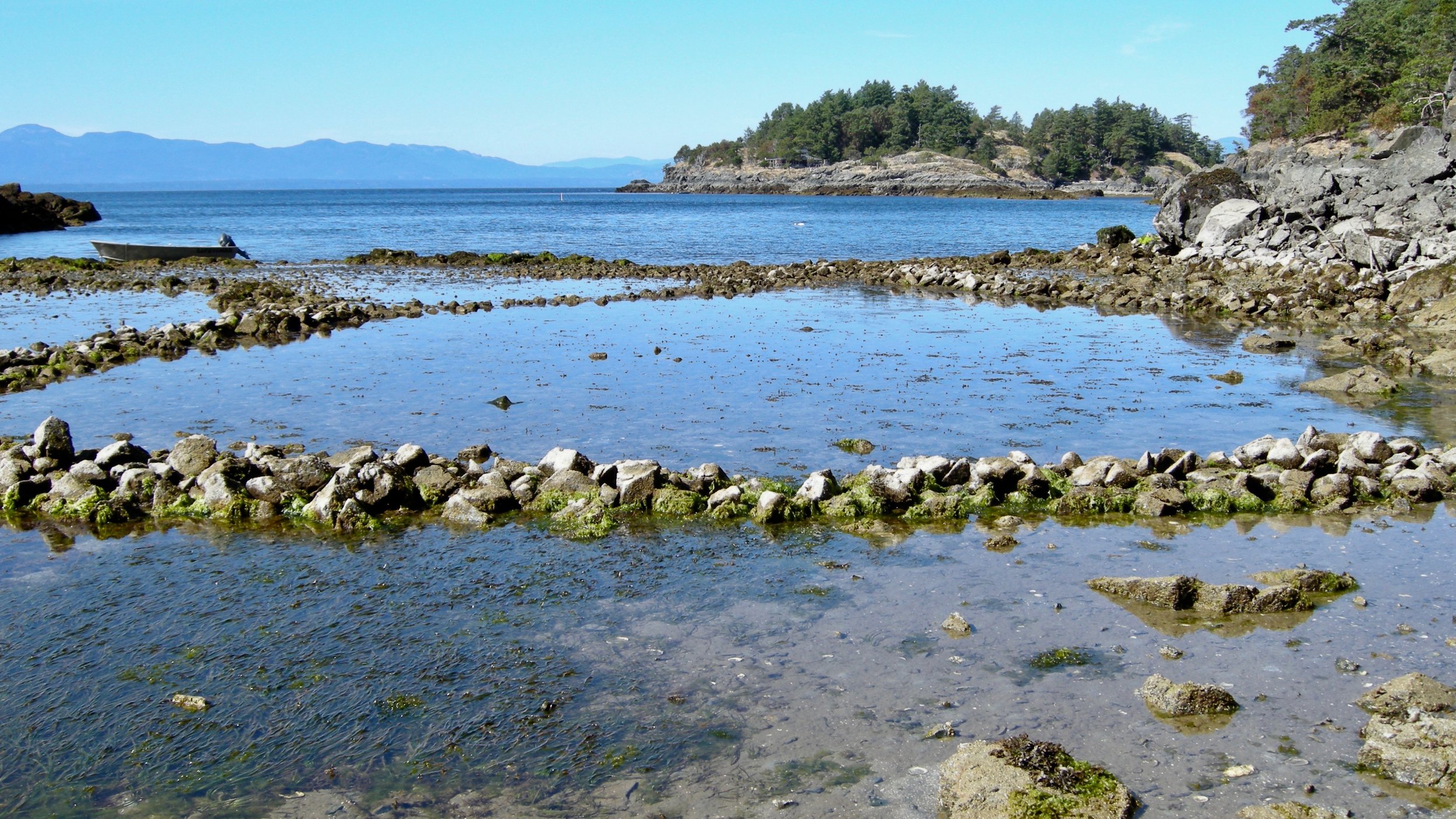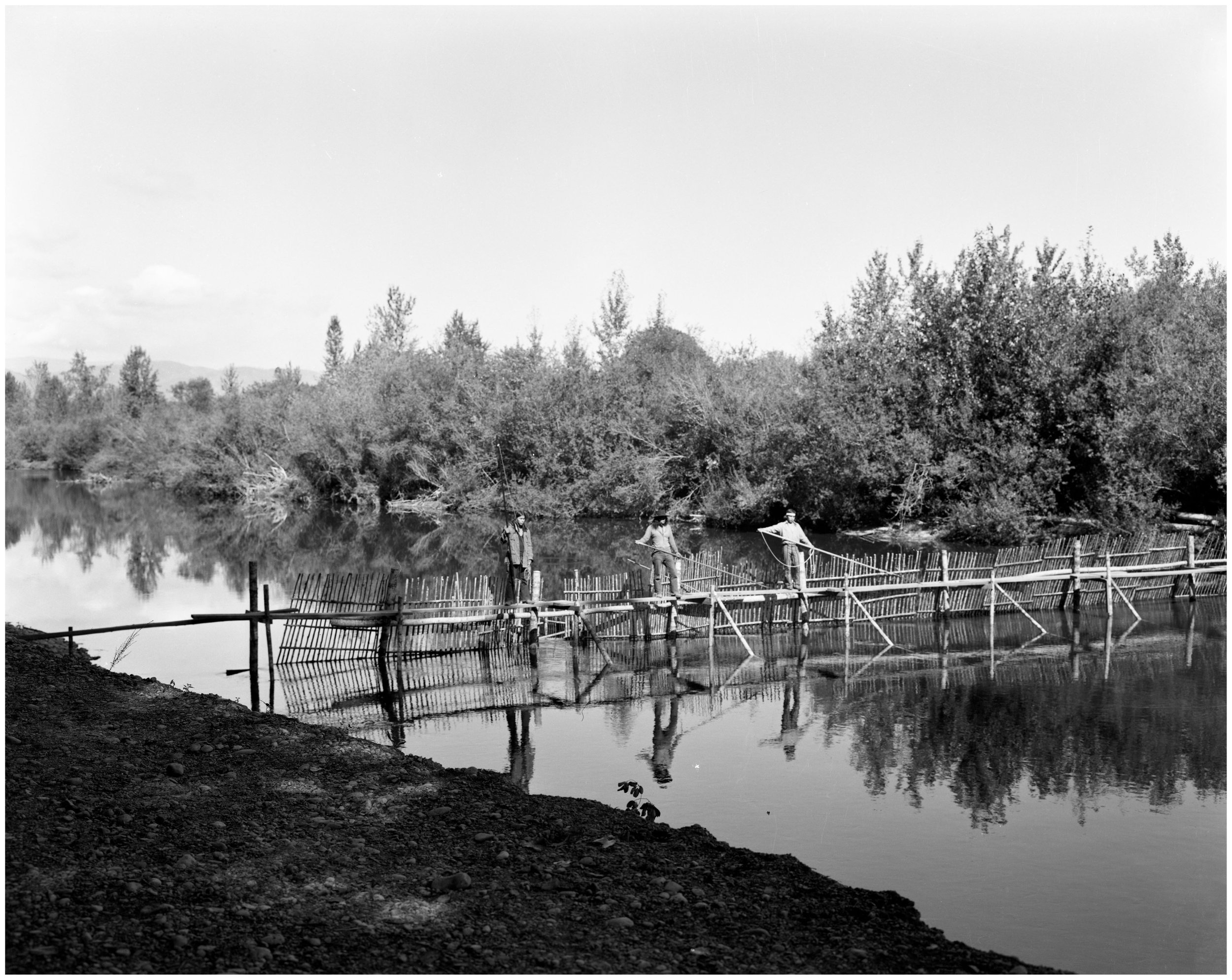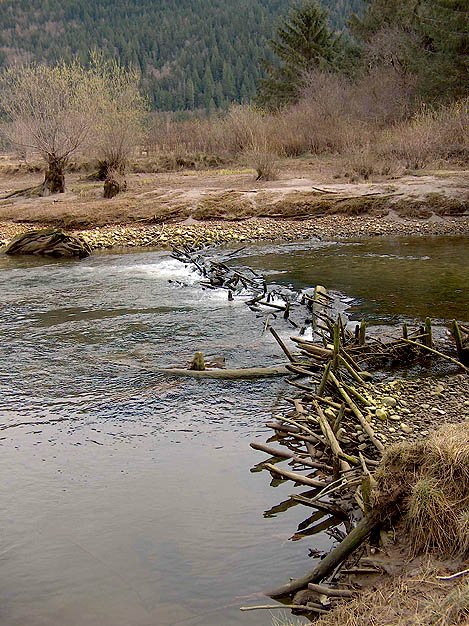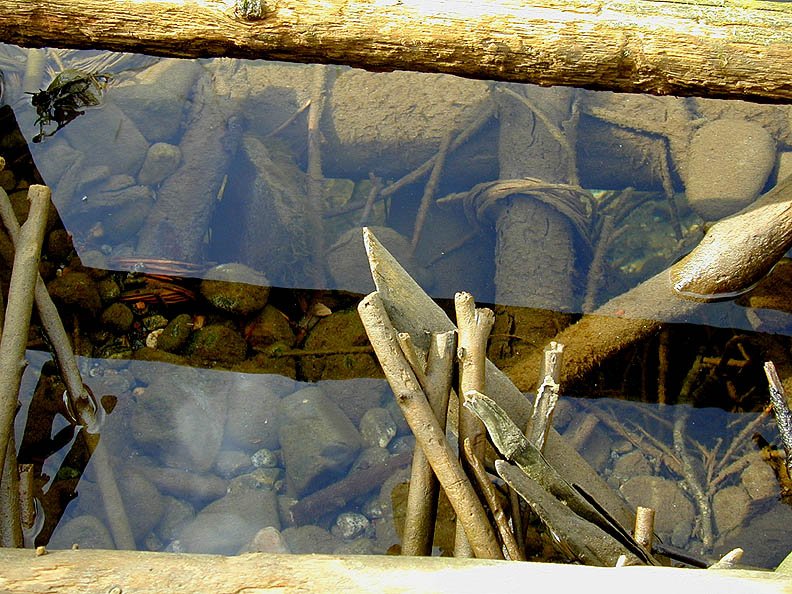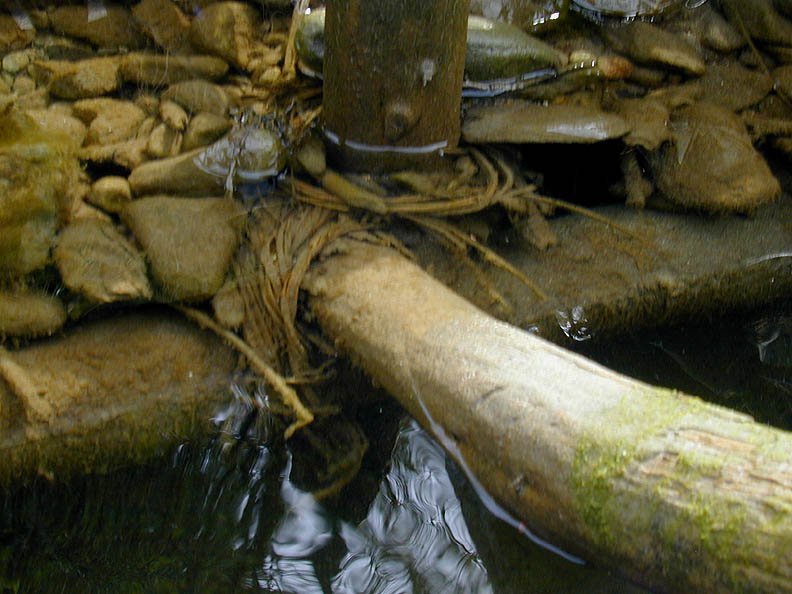tidal traps & weirs of the northwest coast of north america
By Dana Lepofsky
Stone fish trap on Lasqueti Island, British Columbia - Photo by Raymond Lipovsky
Around the globe, and throughout time, coastal peoples have built and maintained fish traps and weirs as ways to harvest and tend fish en masse (Connaway 2007). On the Northwest Coast of North America, from coastal Alaska to Oregon state, fish traps and weirs are one of many marine management practices that have shaped and were shaped by Indigenous cultures and their land- and seascapes (Moss 2013). Here we focus on tidally influenced features in four regions of the coast (Southeast Alaska, Haíłzaqv Territory, North Coast Salish Territory, and the Oregon Coast), but riverine weirs with no tidal influence were also important features in Northwest Coast social-ecological contexts (e.g., Ritchie and Angelbeck 2020).
Both weirs (to obstruct and/or guide fish movement) and traps (to catch and impound fish) were used by people of the Northwest Coast. The coastal features, including those on the lower portions of rivers and streams, entrapped fish by working with tides (Langdon 2006). That is, fish swim in or over the features on high tides and then are trapped on the receding tides by some kind of barrier (a one-way trap, a fence, a high stone wall).
Weirs and traps varied in design to accommodate specific ecological and physical settings and to capture particular assemblages of species. The species caught varied with place, time, and feature design as ecological and social conditions changed (e.g., Greene et al. 2015 Smethurst 2014). While ethnographic information sometimes highlights a particular species (e.g., White 2006), the archaeological record suggests that many species were caught in traps and weirs and were valued harvests (Monks 1987; Smethurst 2014). Of course, it can be difficult to know for certain which fish remains found archaeologically are directly associated with those harvested from spatially associated trap and weir features (e.g., Smethurst 2014; Caldwell 2018). Of the fish trapped in these features, some were harvested immediately (using techniques such as nets and spears), while others were left in holding ponds often associated with these features (Lepofsky 2008). Some traps are complex features that are designed to attract and/or cultivate taxa other than finfish (e.g., Caldwell et al. 2012).
Traps and weirs are found alone or in combination and were made of both wood and/or stone (e.g., Stewart 2018). Thousands of archaeological fish traps and weirs have been recorded on the Northwest Coast (Moss 2013). Many more have been destroyed or buried through recent foreshore activities but also through complex geomorphological processes associated with changing sea levels (Moss and Erlandson 1998; Tveskov and Erlandson 2003). The majority of known archaeological features are recorded as stone traps. However, this likely reflects a bias introduced by the fact that stone features are more durable and visible than wooden stakes whose bases are only preserved in fine, anaerobic sediments. This bias also reflects the fact that few archaeologists have actually excavated stone fish traps. When they do, they find stone foundations originally held wooden weir or trap features (e.g., Haíłzaqv Fish Traps; Heiltsuk First Nation 2022). Importantly, there are many attributes within traps and weirs that are shared coast-wide and that are used in different combinations depending on the setting (Caldwell et al. 2012). Notably, there is continuity in overall forms of traps and weirs across the region and through time (e.g., heart-shaped traps; Moss 2013).
Those features that have been dated on the coast range from ~5500 BP (Moss 2013:327) to the last few hundred years (see photo below). Importantly, fish traps are prevalent throughout the age-old oral traditions of coastal First Nations (e.g., Heiltsuk First Nation, 2022), and there is considerable knowledge about how these features can and should function embedded both in ancestral governance principles, language, stories, and memories (e.g., Tveskov and Erlanson 2003; White 2006; Smethurst 2014).
Cowichan river fish weir 1973 - Courtesy of UBC Museum of Anthropology, image ID (a038179) (Anthony Carter).
Though we tend to think of fish traps and weirs as discrete features and associated actions, they are in reality part of a larger complex of marine management practices that span the intertidal, as well as up coastal streams and rivers (see clam gardens and root gardens) (Caldwell et al. 2012; Jackley et al. 2016; Mathews and Turner 2017; Heiltsuk First Nation 2022 ). We are most cognizant of those practices that leave physical remains, but other ancestral practices -- such as the transplanting of salmon and herring eggs and controlling and monitoring harvests through customary laws -- are less visible but no less central to traditional management systems (Jones 2002; Lepofsky and Caldwell 2013; Gauvreau et al 2017a). Kincentric world views shared by many Northwest Coast peoples (Turner 2005) means that many fish are treated as respected kin who are honored through all stages of harvest, processing, consumption, and disposal (Cullon 2017; Heiltsuk First Nation 2022). Such beliefs encompass culture-specific ways in which fish traps and weirs are appropriately used (e.g., Losey 2010; Ritchie and Angelbeck 2020). In some Northwest Coast cultures, the construction, maintenance, and control of traps and weirs was the task of family groups; in others it was the responsibility of the “chief” of variously sized social groupings (Haíłzaqv Fish Traps); in still others we do not know how local governance was enacted in the management of traps and weirs in the past. Such place-specific and long-term knowledge and customs dictating people-fish interactions for fish stands in sharp contrast to the industrial fishing practices currently practiced in the Pacific Northwest today.
Throughout the coast, paralleling patterns across the world (Bradley and McNiven 2018), fish trap use has dramatically declined in the last few centuries. There are a myriad of factors that influenced this decline, but among them are centralized colonial governmental restrictions on the building and use of fish traps (e.g., Tveskov and Erlanson 2003), decline in fish stocks due to overfishing, habitat degradation, and warming oceans, and shifts in Indigenous social structures. However, as with many ancestral marine innovations, there is a strong recognition today among coastal peoples of the Northwest Coast of the importance of traditional management of their fish (e.g., Gauvreau et al 2017b; Atlas et al. 2021), and the social and ecological value in restoring traditional fish weirs and the local governance structures associated with them (e.g., Atlas et al. 2017).
References
Atlas, W. I., N. C. Ban, J. W. Moore, A. M. Tuohy, S. Greening, A. J. Reid, N. Morven, E. White, W. G. Housty, J. A. Housty, C. N. Service, L. Greba, S. Harrison, C. Sharpe, K. I. R. Butts, W. M. Shepert, E. Sweeney-Bergen, D. Macintyre, M. R. Sloat, and K. Connors. 2021. Indigenous systems of management for culturally and ecologically resilient Pacific salmon (Oncorhynchus spp.) fisheries. BioScience 71:186–204.
Atlas, W. I., W. G. Housty, A. Béliveau, B. DeRoy, G. Callegari, M. Reid, and J. W. Moore. 2017. Ancient fish weir technology for modern stewardship: lessons from community-based salmon monitoring. Ecosystem Health and Sustainability 3:1341284.
Bradley, J., and I. J. McNiven. 2019. “Why those old fellas stopped using them?”: Socio-religious and socio-political dimensions of stone walled tidal fish trap use and dis-use amongst the Yanyuwa of North Australia. The Journal of Island and Coastal Archaeology 14:337–355.
Caldwell, M.E. 2015. Northern Coast Salish marine resource management. PhD Dissertation, Dept. of Anthropology, University of Alberta, Edmonton, AB.
Caldwell, M. E., D. Lepofsky, G. Combes, M. Washington, J. R. Welch, and J. R. Harper. 2012. A bird’s eye view of Northern Coast Salish intertidal resource management features , Southern British Columbia, Canada. The Journal of Island and Coastal Archaeology 7:219–233.
Connaway, J. M. 2007. Fishweirs: a world perspective with emphasis on the fishweirs of Mississippi. Mississippi Department of Archives and History, Jackson.
Cullon, D. 2017. Dancing salmon: human-fish relationships on the Northwest Coast. PhD dissertation, Dept. of Anthropology, University of Victoria, BC.
Gauvreau, A. M., D. Lepofsky, M. Rutherford, and M. Reid. 2017a. Response to: Everything revolves around the herring: the Heiltsuk-herring relationship through time. Ecology and Society 22:29.
Gauvreau, A., D. Lepofsky, M. Rutherford, and M. Reid. 2017b. “Everything revolves around the herring”: the Heiltsuk–herring relationship through time. Ecology and Society 22:10.
Green, N. A., M. D. Lepofsky, and M. R. Rutherford. 2015. The Comox Harbour fish trap complex: A large-scale, technologically sophisticated intertidal fishery from British Columbia. Canadian Journal of Archaeology 39:161–212.
Heiltsuk First Nation. 2022. Húy̓at Fish Traps web page. http://www.hauyat.ca/living/tending-and-harvesting-2/traps-and-gardens-2/fish-traps.html, Accessed 25 January 2022.
Jackley, J., L. Gardner, A. F. Djunaedi, and A. K. Salomon. 2016. Ancient clam gardens, traditional management portfolios, and the resilience of coupled human-ocean systems. Ecology and Society 21:20.
Jones, J. T. 2022. We looked after all the salmon streams. Masters Thesis, School of Environmental Studies, University of Victoria, BC.
Menzies, C. R., editor. 2006. Traditional ecological knowledge and natural resource management. University of Nebraska Press, Lincoln.
Lepofsky, D. 2008. Marshall’s beach fish trap, Lasqueti Island. The Midden 31:10 -11.
Lepofsky, D., and M. Caldwell. 2013. Indigenous marine resource management on the Northwest Coast of North America. Ecological Processes 2:12.
Losey, R. 2010. Animism as a means of exploring archaeological fishing structures on Willapa Bay, Washington, USA. Cambridge Archaeological Journal 20:17–32.
Mathews, D. L., and Turner, N. J. 2017. Ocean cultures: Northwest Coast ecosystems and Indigenous management systems. Pages 169–99 in P. S. Levin and M. R. Poe (eds.), Conservation for the Anthropocene ocean: interdisciplinary science in support of nature and people. Academic Press, San Diego, CA.
Monks, G. G. 1987. Prey as bait: the Deep Bay example. Canadian Journal of Archaeology 11:119–142.
Moss, M.L. 2013. Fishing traps and weirs on the Northwest Coast of North America: New approaches and new insights. Pages 323-337 F. Menotti and A. O'Sullivan (eds.), The Oxford Handbook of Wetland Archaeology [online].
Moss, M.L. and J.M. Erlandson. 1998. A comparative chronology of Northwest Coast fishing features, pages 180-198, K. Bernick (ed.), Hidden Dimensions, The Cultural Significance of Wetland Archaeology. UBC Press, Vancouver.
Smethurst, N.H. 2014. Inscribed on the landscape: stories of stone traps and fishing in Laxyuup Gitxaala. MA Thesis, Department of Anthropology, University of British Columbia, Vancouver.
Ritchie, M., and B. Angelbeck. 2020. “Coyote broke the dams”: power, reciprocity, and conflict in fish weir narratives and implications for traditional and contemporary fisheries. Ethnohistory 67:191–220.
Stewart, H. 2018. Indian Fishing: early methods on the Northwest Coast. Douglas & McIntyre, Vancouver.
Turner, N. J. 2005. The earth’s blanket: traditional teachings for sustainable living. University of Washington Press, Seattle.
Tveskov, M. A., and J. M. Erlandson. 2003. The Haynes Inlet weirs: estuarine fishing and archaeological site visibility on the southern Cascadia coast. Journal of Archaeological Science 30:1023–1035.
White, E. A. F. (Xanius). 2006. Heiltsuk stone fish traps: products of my ancestor’s labour. MA Thesis, Department of Archaeology. Simon Fraser University, Burnaby.
